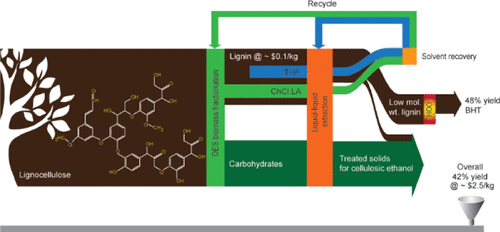当前位置:
X-MOL 学术
›
ACS Sustain. Chem. Eng.
›
论文详情
Our official English website, www.x-mol.net, welcomes your
feedback! (Note: you will need to create a separate account there.)
Biphasic Separation Approach in the DES Biomass Fractionation Facilitates Lignin Recovery for Subsequent Valorization to Phenolics
ACS Sustainable Chemistry & Engineering ( IF 7.1 ) Pub Date : 2020-12-15 , DOI: 10.1021/acssuschemeng.0c07747 Sandeep Kumar 1, 2 , Shelja Sharma 1 , Senthil Murugan Arumugam 1 , Chirag Miglani 3 , Sasikumar Elumalai 1
ACS Sustainable Chemistry & Engineering ( IF 7.1 ) Pub Date : 2020-12-15 , DOI: 10.1021/acssuschemeng.0c07747 Sandeep Kumar 1, 2 , Shelja Sharma 1 , Senthil Murugan Arumugam 1 , Chirag Miglani 3 , Sasikumar Elumalai 1
Affiliation

|
Herein, we demonstrate a sustainable technique for quality facile lignin recovery by adopting a biphasic separation approach during the deep eutectic solvent (DES) disintegration of biomass for subsequent valorization. The tetrahydrofuran (THF)/aq NaCl combination influenced the attainment of biphasic layer separation, consequently accelerating the movement of DES-solubilized lignin to the organic phase and allowing for the easy recovery of lignin and solvents (both THF and DES) for reuse. The modified protocol facilitated ∼32% wt lignin per wt of sawdust with a 95% purity (based on a Klason analysis), which was nearly 88% of the lignin extracted to the potential lignin of sawdust. This was achieved through the fractionation of sawdust using a choline chloride and lactic acid combination at a 1:2 molar ratio under modest thermal conditions. The obtained results were ∼2-fold higher than those of the conventional DES protocol, employing the H2O–EtOH mixture for lignin precipitation using a similar wood substrate. All of the analytical characterization techniques, including 13C NMR, Fourier transform infrared, gel permeation chromatography, and pyrolysis-gas chromatography-mass spectrometry (Py-GC/MS), established the relevant structural and morphological characteristics, making the resultant lignin an adequate feedstock for the potential production of aromatic chemicals because of the dominance of the β-O-4 content and the limited residual constituents, including sugars and silica. Upon evaluating its suitability for phenolic chemical synthesis via hydrogenolysis, a ∼48% butylated hydroxytoluene yield was obtained as a dominant phenolic product over heterogeneous Ru@V2O5. Overall, the findings indicated that DES is proficient in fractionating lignocellulose for the entire release of lignin (>90%). The maximum recovery of the released lignin was attributed to the superlative performance of the novel THF/aq NaCl combination through the influence of molecular interactions, such as hydrogen bonding and dipole–dipole interactions between the lignin and solvent, thereby establishing an alternative trend for quality lignin extraction for deriving phenolics.
中文翻译:

DES生物质分馏中的双相分离方法可促进木质素的回收,从而对酚类化合物进行随后的价衡。
在本文中,我们通过在生物质的深共熔溶剂(DES)分解过程中采用双相分离方法,以进行后续的增值,展示了一种用于回收质量可靠的木质素的可持续技术。四氢呋喃(THF)/ NaCl水溶液的组合影响了两相层分离的实现,因此加速了DES溶解的木质素向有机相的移动,并易于回收木质素和溶剂(THF和DES)以便重复使用。修改后的方案可促进每重量木屑约32%重量的木质素,其纯度为95%(基于Klason分析),几乎是提取为潜在木屑木质素的88%的木质素。这是通过在适度的热条件下,使用氯化胆碱和乳酸的组合物以1:2的摩尔比分馏锯末来实现的。2 O-EtOH混合物,用于使用相似的木质底物沉淀木质素。所有的分析表征技术,包括13 C NMR,傅立叶变换红外光谱,凝胶渗透色谱法和热解-气相色谱-质谱法(Py-GC / MS),都建立了相关的结构和形态特征,从而使生成的木质素足够β-O-4含量占优势,残留成分有限,包括糖和二氧化硅,因此可用于生产芳香族化学品。在评估其适用于通过氢解进行酚类化学合成的适用性后,获得了约48%的丁基化羟基甲苯收率,这是多相Ru @ V 2 O 5的主要酚类产物。。总体而言,研究结果表明,DES在木质素的全部释放(> 90%)中能熟练地分离木质纤维素。释放的木质素的最大回收率归因于新型THF / aq NaCl组合在分子相互作用(例如木质素与溶剂之间的氢键和偶极-偶极相互作用)的影响下的最高性能,从而建立了质量的另一种趋势木质素提取物用于衍生酚类。
更新日期:2020-12-15
中文翻译:

DES生物质分馏中的双相分离方法可促进木质素的回收,从而对酚类化合物进行随后的价衡。
在本文中,我们通过在生物质的深共熔溶剂(DES)分解过程中采用双相分离方法,以进行后续的增值,展示了一种用于回收质量可靠的木质素的可持续技术。四氢呋喃(THF)/ NaCl水溶液的组合影响了两相层分离的实现,因此加速了DES溶解的木质素向有机相的移动,并易于回收木质素和溶剂(THF和DES)以便重复使用。修改后的方案可促进每重量木屑约32%重量的木质素,其纯度为95%(基于Klason分析),几乎是提取为潜在木屑木质素的88%的木质素。这是通过在适度的热条件下,使用氯化胆碱和乳酸的组合物以1:2的摩尔比分馏锯末来实现的。2 O-EtOH混合物,用于使用相似的木质底物沉淀木质素。所有的分析表征技术,包括13 C NMR,傅立叶变换红外光谱,凝胶渗透色谱法和热解-气相色谱-质谱法(Py-GC / MS),都建立了相关的结构和形态特征,从而使生成的木质素足够β-O-4含量占优势,残留成分有限,包括糖和二氧化硅,因此可用于生产芳香族化学品。在评估其适用于通过氢解进行酚类化学合成的适用性后,获得了约48%的丁基化羟基甲苯收率,这是多相Ru @ V 2 O 5的主要酚类产物。。总体而言,研究结果表明,DES在木质素的全部释放(> 90%)中能熟练地分离木质纤维素。释放的木质素的最大回收率归因于新型THF / aq NaCl组合在分子相互作用(例如木质素与溶剂之间的氢键和偶极-偶极相互作用)的影响下的最高性能,从而建立了质量的另一种趋势木质素提取物用于衍生酚类。




















































 京公网安备 11010802027423号
京公网安备 11010802027423号